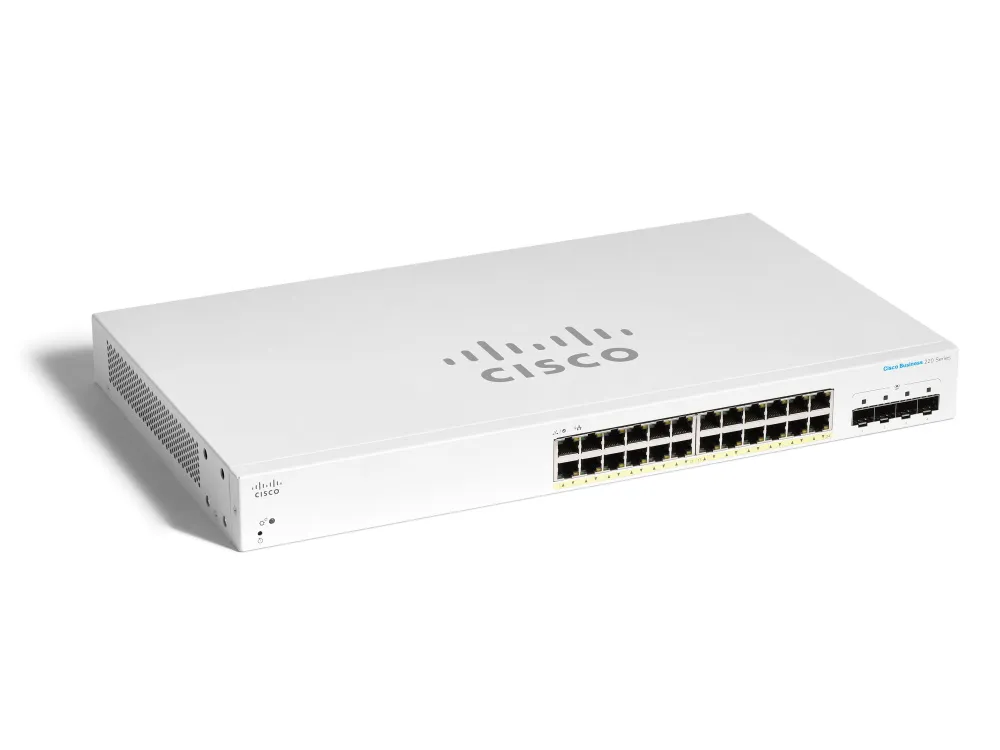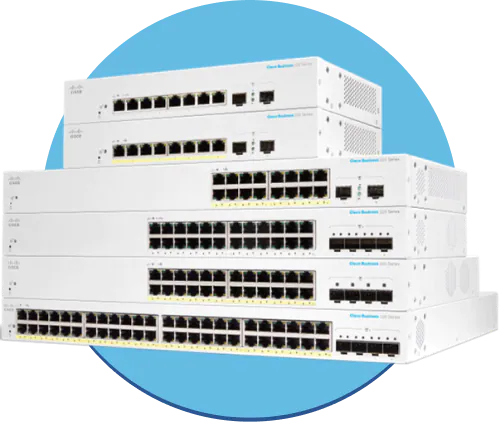Cisco CBS220-24FP-4G | Switch | 24x RJ45 1000Mb/s PoE, 4x SFP, Desktop, Rack, 382W


TheCisco Business 220 Series is an affordable, intelligent switch that provides ease of use, security, and reliability for business-class networks. With an intuitive control panel, Power over Ethernet (PoE) options, and configurable features, these switches deliver a reliable business network within budget parameters. If you need a business-class network and cost is a top priority, the Cisco Business 220 Series is the ideal solution.

The Cisco CBS220-24FP-4G is a professional Layer 2 switch with extensive management features and robust network security. This model has 24 Gigabit Ethernet ports and 4 Gigabit SFP uplink ports. With 56 Gbps throughput, it creates lightning fast connections to connected devices such as access points, computers, and IP phones. All Gigabit Ethernet ports on the Cisco CBS220-24FP-4G support full PoE (802.3at) power with a total power budget of at least 382 watts. This means that you can power devices directly over the network cable, as long as they also support PoE. This way, you do not need a separate outlet for each device. The Cisco CBS220-24FP-4G supports the energy-efficient Ethernet standard (IEEE 802.3az) to save power. Power consumption is adjusted according to cable length and port traffic. In addition, the port automatically enters sleep mode when it is idle.

With Cisco Business 220 Series Switches, you can not only build an efficient and reliable network to connect your workforce, but also create advanced solutions for delivering data, voice, and video services over a converged infrastructure. Get the best value for your money by increasing employee productivity.
Possible deployment scenarios include: Networking for small offices. The versatility and affordability of the Cisco Business 220 Series provides the ideal foundation for a business-class network for small businesses with limited IT support and budgets.

| Features / filters | |
| LAN standard | Gigabit Ethernet 10/100/1000 Mb/s |
| Number of LAN ports | 24x [10/100/1000M (RJ45)] , 4x [1G (SFP)] , |
| Number of PoE ports | 24x [802.3af/at (1G)] |
| Built-in modem | None |
| Management | By web browser |
| Power (W) | 382 |
| Switching layer | 2 |
| Type of case | Rack (1U), Desktop, |
| Basic general data | |
| Manufacturer | Cisco |
| Model | CBS220-24FP-4G |
| Type | Switch |
| Performance characteristics | |
| Throughput in millions of packets per second (mpps) (64-byte packets) | 41.66 mpps |
| Gigabit per second (Gbps) switching capacity | 56 |
| Layer 2 switching functions | |
| MAC table | Up to 8,192 MAC addresses (Media Access Control) |
| Spanning Tree Protocol (STP) | Standard 802.1d spanning tree support, enabled by default. Rapid convergence using 802.1w (Rapid Spanning Tree [RSTP]) Support for multiple spanning tree instances using 802.1s (MSTP) 16 instances are supported |
| Port Grouping | Support for IEEE 802.3ad Link Aggregation Control Protocol (LACP) Up to 8 groups Up to 8 ports per group with 16 candidate ports for each (dynamic) 802.3ad link aggregation Load balancing based on source and destination MAC address or source and destination MAC/IP address |
| VLAN | Support for up to 256 virtual local area networks (VLANs) simultaneously Port-based and 802.1Q tag-based VLANs Management VLAN Guest VLAN |
| Automatic voice VLAN | Voice traffic is automatically assigned to its specific VLAN and treated with the appropriate QoS level. |
| QinQ VLAN | VLANs transparently traverse the service provider's network while isolating traffic among clients |
| Generic VLAN Registration Protocol (GVRP) and Generic Attribute Registration Protocol (GARP) | Protocols for automatically propagating and configuring VLANs in a bridged domain. |
| HOL (Head-of-Line) Blocking | Prevention of HOL blockage |
| Jumbo frames | Supported frame sizes up to 9,216. |
| Loopback detection | Loopback detection provides loopback protection by sending loopback protocol packets from ports on which loopback protection is enabled. It operates independently of STP. |
| Automatic switching between media-dependent interfaces (MDIX) | Automatically adjusts the transmit and receive pairs if an incorrect cable type (crossover or straight) is installed. |
| Security | |
| ACLs | Remove or restrict bandwidth based on source and destination MAC address, VLAN ID or IP address, protocol, port, Differentiated Services Code Point (DSCP)/IP priority, Transmission Control Protocol (TCP)/User Datagram Protocol (UDP) source and destination port, 802.1p priority, Ethernet type, Internet Control Message Protocol (ICMP) packets, Internet Group Management Protocol (IGMP) packets, TCP flag Supports up to 512 rules |
| Port security | Ability to block source MAC addresses on ports; limit the number of MAC addresses learned |
| IEEE 802.1X (authentication role) | 802.1X: Remote Authentication Dial-in User Service (RADIUS); guest VLAN; Single-host, multiple-host and multisession modes. |
| RADIUS, TACACS | Supports RADIUS authentication and Terminal Access Control System (TACACS); the switch operates as a client |
| MAC Address Filtering | Supported page |
| Storm control | Broadcast, multicast and unknown unicast |
| Protection against DoS attacks | Prevention of DOS attacks |
| STP Bridge Data Unit (BPDU) Guard Protocol | This security mechanism protects the network from incorrect configurations. A port enabled for BPDU Guard is disabled if a BPDU message is received on that port. |
| Spinning Tree Loop Guard | This feature provides additional protection against Layer 2 forwarding loops (STP loops). |
| Secure Shell (SSH) Protocol | SSH is a secure replacement for the Telnet protocol. SCP also uses SSH. SSH v1 and v2 are supported. supported. |
| Secure Sockets Layer (SSL) | SSL Support: Encrypts all HTTPS traffic, enabling highly secure access to the browser-based management GUI on the switch. |
| QoS | |
| Priority levels | 8 hardware queues per port |
| Scheduling | Strict priority and Weighted Round-Robin (WRR) queues assigned based on DSCP and Class of Service (802.1p/CoS) |
| Class of service | Port-based; 802.1p VLAN priority-based; IPv4/v6 IP precedence, Type of Service (ToS) and DSCP; Differentiated Services (DiffServ); ACL classification and relabeling, trusted QoS |
| Speed limitation | Inbound policing; outbound shaping and rate control; per VLAN, per port and flow-based |
| Avoiding congestion | A TCP congestion avoidance algorithm is required to reduce and prevent global TCP loss synchronization. Synchronization. |
| IPv6 | |
| IPv6 | IPv6 host mode IPv6 over Ethernet Dual stack IPv6/IPv4 IPv6 Neighbor and Router Detection (ND) Stateless IPv6 address auto-configuration Maximum Transmission Unit (MTU) per Path Detection Duplicate Address Detection (DAD) ICMP version 6 |
| IPv6 ACL | Dropping or rate limiting IPv6 packets in hardware |
| IPv6 QoS | Hardware-based prioritization of IPv6 packets |
| Multicast listener detection (MLD v1/2) Snooping | Deliver IPv6 multicast packets only to required recipients |
| IPv6 applications | Web/SSL, Telnet/SSH server, DHCP client, DHCP Autoconfig, Cisco Discovery Protocol (CDP), Link Layer Discovery Protocol (LLDP) |
| Management functions | |
| Cisco Business Dashboard | Direct management support with Cisco Business Dashboard and mobile app. Eliminates the need to configure separate hardware or virtual machine for on-premise Cisco Business Dashboard probes. |
| Cisco Business mobile app | Mobile app for Cisco Business Switch and Wireless products. Helps you configure your local network within and provides easy management at your fingertips. |
| Cisco Network Plug and Play (PnP) agent | The Cisco Network Plug and Play solution is a simple, secure, unified, and integrated offering that makes it easy to deploy new devices in branch offices and campuses or upgrade an existing network. The solution provides a unified approach to delivering Cisco routers, switches, and wireless devices in a zero-touch deployment. Cisco PnP Connect support |
| Web user interface | Built-in switch configuration utility for easy device configuration via browser (HTTP/HTTPS). Support for configuration, dashboard, maintenance and system monitoring |
| Text-editable configuration files | Configuration files can be edited with a text editor and downloaded to another switch, facilitating mass deployment. |
| Command line interface | Scriptable CLI; full CLI is supported. User privilege levels 1 and 15 are supported for the CLI. |
| SNMP | Simple Management Network Protocol (SNMP) versions 1, 2c and 3 with support for traps and SNMP version 3 User-based security model (USM) |
| Remote monitoring (RMON) | The built-in RMON software agent supports 4 RMON groups (history, statistics, alarms and events) to improve traffic management, monitoring and analysis. |
| Dual stack IPv4 and IPv6 | Coexistence of both protocol stacks facilitates migration |
| Reproduction of ports | Traffic on a port or VLAN can be mirrored to another port for analysis using a network analyzer or RMON probe. Up to 8 source ports can be mirrored to one destination port. Four sessions are supported. |
| Firmware Update | Upgrade over web browser (HTTP/HTTPS) and TFTP (Trivial File Transfer Protocol) Dual images for a robust firmware update |
| DHCP (Option 12, 66, 67, 82, 129 and 150) | DHCP options allow tighter control from a central point (DHCP server) for IP address, auto-configuration (with configuration file download), DHCP forwarding and hostname. |
| Time synchronization | Simple Network Time Protocol (SNTP) |
| Login banner | Configurable multiple banners for both website and CLI |
| Other management | HTTP/HTTPS; TFTP update; DHCP client; Bootstrap Protocol (BOOTP); cable diagnostics; ping; traceroute; syslog |
| Power over Ethernet | |
| 802.3af PoE or 802.3at PoE provided by any of the RJ-45 network ports within the specified power budgets | |
| PoE power budget | 382 W |
| Number of PoE-capable ports | 24 |
| Hardware features | |
| Buttons | Reset button |
| Wiring type | Category 5 Unshielded Twisted Pair (UTP) or better for 10BASE-T/100BASE-TX; Category 5 UTP Ethernet or better for 1000BASE-T |
| LEDs | System, Link/Act, Speed |
| Flash | 64 MB |
| CPU memory | 256 MB |
| Ports | |
| Total number of system ports | 28 x Gigabit Ethernet |
| RJ-45 ports | 24 x Gigabit Ethernet |
| Uplink ports | 4 x Gigabit Ethernet SFP |
| Packet buffer | 4.1 Mb |
| Environmental features | |
| Dimensions | 440 x 257 x 44 mm (17.3 x 10.1 x 1.7 in) |
| Weight | 4.10 kg (9.04 lb) |
| Operating temperature | 0-50° C |
| Storage temperature | -20° C to 70° C |
| Humidity during operation | 10% to 90%, relative, non-condensing |
| Storage Humidity | 10% to 90%, relative, non-condensing |
| System power consumption | 110V=30.8W 220V=30.8W |
| Power consumption (with PoE) | 110V=459W 220V=445W |
| Heat dissipation (BTU/hour) | 1,566.17 |
| Acoustic Noise and Mean Time Between Failure (MTBF) | |
| Fan (quantity) | 2 |
| Acoustic noise | 25°C: 43.2 dB |
| MTBF @ 25°C (hours) | 588,411 |
The Cisco CBS220-24FP-4G switch supports 24 ports of PoE power .